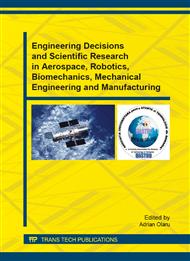[1]
Lin, Shih-Chieh. The use of variable spindle speed for vibration control in face milling process AAI9010937, (UMI)AAI9010937, 2011-05-07.
Google Scholar
[2]
Altintas, Y. Manufacturing Automation. United States of America: 1. Ed. Cambridge University Press, 288 pg, (2000).
Google Scholar
[3]
Information on http: /www2. unitbv. ro/LinkClick. aspx?fileticket=s7zzua6eTbk%3D&tabid=4579.
Google Scholar
[4]
C. E. O. da Silva, E. Villani, J. de Oliveira Gomes, Direct access of CNC data for vibration control, ABCM Symposium Series in Mechatronics - Vol. 4 - pp.553-558 (2010).
Google Scholar
[5]
Julie Z.Z. and Joseph C.C. Tool condition monitoring in an end-milling operation based on the vibration signal collected through a microcontroller-based data acquisition system. International Journal of Advanced Manufacturing Technology; 39: 118-128 (2008).
DOI: 10.1007/s00170-007-1186-6
Google Scholar
[6]
Jemielniak K. Commercial tool condition monitoring systems. International Journal of Advanced Manufacturing Technology, 15 (4): 711–721 (1999).
DOI: 10.1007/s001700050123
Google Scholar
[7]
Dimla D.E. Sensors signals for tool-wear monitoring in metal cutting operations - A Review of methods. International Journal of Machine tools and Manufacture; 40: 1073–1098, (2000).
DOI: 10.1016/s0890-6955(99)00122-4
Google Scholar
[8]
Xiaoli Li. A brief review: acoustic emission method for tool wears monitoring during turning. International Journal of Machine tools and Manufacture; 42: 157–165 (2002).
DOI: 10.1016/s0890-6955(01)00108-0
Google Scholar
[9]
Information on: http: /www. mecanica. scire. coppe. ufrj. br/util/b2evolution/media/blogs/annacarla/A_review_machining_monitoring. pdf.
Google Scholar
[10]
Chen JC., Chen WL., A tool breakage detection system using an accelerometer sensor. J Intell Manuf 10: 187–197 (1999).
Google Scholar
[11]
Bahr B., Motavalli S., Arfi T., Sensor fusion for monitoring machine tool conditions. Int J Comput Integr Manuf 10: 314–323 (1997).
Google Scholar
[12]
Ertekin YM., Kwon Y., Tseng TL., Identification of common sensory features for the control of CNC milling operations under varying cutting conditions. Int J Mach Tools Manuf 43: 897–904, (2003).
DOI: 10.1016/s0890-6955(03)00087-7
Google Scholar
[13]
http: /www. sv-jme. eu/data/upload/2013/06/01_2012_856_Ostasevicius_03. pdf.
Google Scholar
[14]
Simon Haykin, Neural networks and learning machines, Volume 10, Prentice Hall, (2009).
Google Scholar
[15]
Mark Hudson Beale, Martin T. Hagan, Howard B. Demuth, Neural Network Toolbox™ User's Guide.
Google Scholar
[16]
Campean E., Morar L., Baru P., Bordea C., Pop D., Aspects regarding some simulation models for logistic management, Procedia Economics and Finance 00 (2012) 000–000, EFQM, Targu Mures, Romania.
DOI: 10.1016/s2212-5671(12)00270-5
Google Scholar


